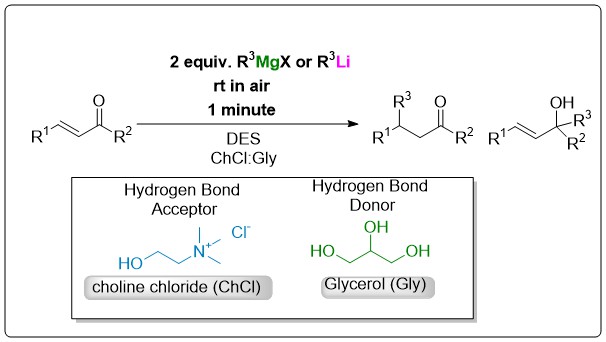Harnessing Deep Eutectic Solvents for Polar Organometallic Additions to α,β-unsaturated Ketones in Air
Polar organometallics additions are found widely in modern chemistry, with most syntheses of medicinal and agrochemical products involving one or more steps, utilizing Grignards or organolithiums. Despite their utility, these reactions typically require inert conditions, cryogenic temperatures (-78°C), as well as use of dry polar solvents.[1] To overcome some of these limitations, deep eutectic solvents have emerged as a powerful alternative. Formed by the combination of a hydrogen bond acceptor (Choline chloride) and hydrogen bond donor (glycerol) to form a uniform liquid with low toxicity and volatility.
Recent developments in polar organometallic chemistry have broken the current dogma requiring inert and cryogenic conditions. Our group along with others [3] have shown that polar organometallic reactions can occur rapidly and outcompete the protonolysis side reaction when in non-traditional protic solvents in air. In this work we show that by harnessing deep eutectic solvents, additions to α,β-unsaturated ketones can occur at room temperature in air, with a wealth of different organometallic reagents and substrates.

[1] J. Clayden,Organolithiums: Selectivity for Synthesis. Perga-mon, Elsevier Science Ltd., Oxford, UK, 2002; The Chemistry of Organomagnesium Compounds, (Eds.: Z. Rappoport,I. Marek), Patai Series, Wiley, Chichester, 2008.
[2] A. P. Abbott, G. Capper, D. L. Davies, H L. Munro, R K. Rasheed, V Tambyrajah Chem comm. 2001, 2010-201; B.B. Hansen, S. Spittle, B. Chen, D. Poe, Y. Zhang, J. M. Klein, A. Horton, L. Adhikari, T. Zelovich, B. W. Doherty, B. Gurkan,E. J. Maginn, A. Ragauskas, M. Dadmun, T. A. Zawodzinski, G. A. Baker,M. E. Tuckerman, R. F. Savinell and J. R. Sangor. Chem Rev, 2021, 121 (3), 1232-1285
[3]. J.Garcia-alvarez, E. Hevia, Angew. Chem. Int. Ed. 2014, 53, 5969 –5973; E.Hevia, Angew. Chem.Int.Ed. 2016, 55,16145; S. E. García-Garrido, A. Presa Soto, E. Hevia and J. García-Álvarez. Eur. J. Inorg. Chem,2021, 3116–3130.